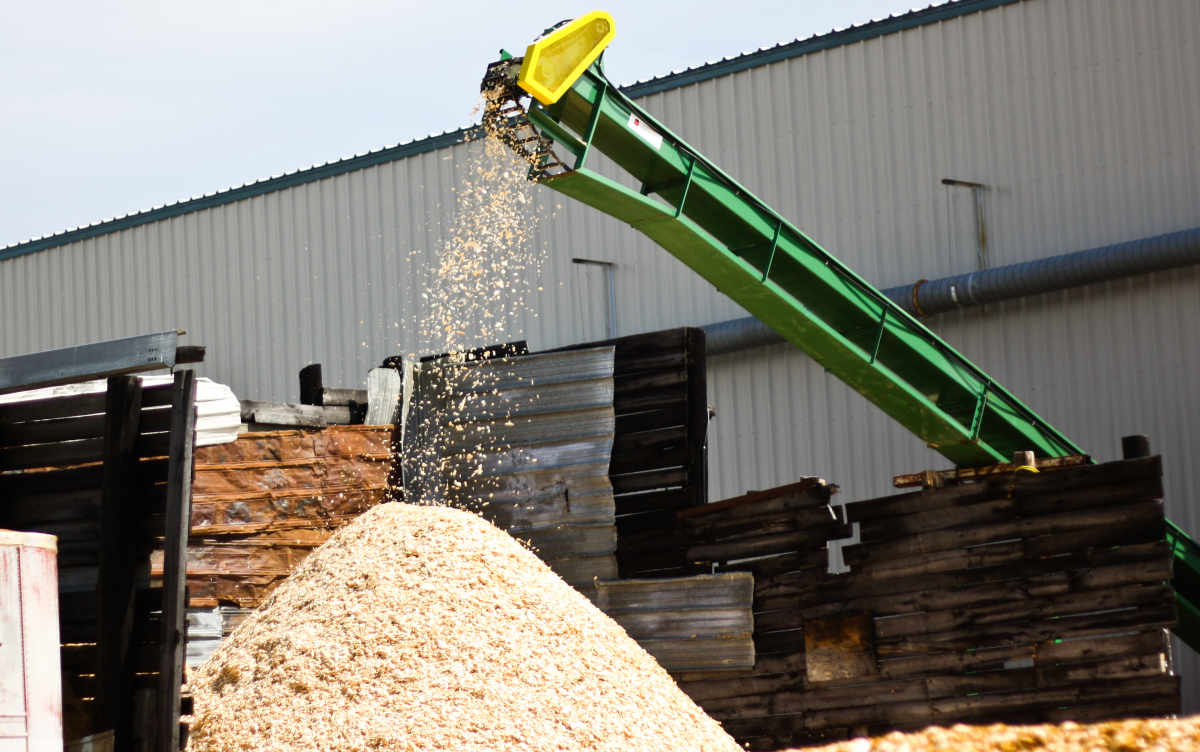Support strong Canadian climate journalism for 2025
The Ontario government has launched a five-year plan to bolster the province’s forestry industry by expanding biomass projects that turn waste wood into energy or useful products.
The forest biomass action plan is designed to open new markets, increase demand for bioenergy and support Indigenous involvement in the biomass industry.
It emphasizes the use of leftover materials from logging, such as bark, wood shavings and sawdust produced by sawmills. But the plan also includes what the Ontario government calls “biofibre”: parts like treetops and branches that aren’t normally turned into forest products.
“Sometimes there are resources that don’t have a commercial value to industry that, if left on the site, create a challenge for getting really good [forest] renewal,” said Jason Koivisto, manager of forestry innovation and market development at the Ministry of Northern Development, Mines, Natural Resources and Forestry.
In northern Ontario, there are five biomass generating stations powered by material from sawmills and panel mills. In parallel with the action plan, the province is extending the energy contracts for these stations.
“The hope is that we diversify and grow the industry,” said Koivisto. “Some of it will be new companies coming in, some will be other industries [that] need to address their own carbon footprint and are looking for solutions to help them bridge to that net-zero future.”
The Ontario government also plans to advocate for the benefits of biomass under the federal government’s clean fuel standard.
Although the Ontario government bills the expansion as sustainable, biomass projects — especially those that burn wood for energy — are contentious. Environmental advocates warn they are based on faulty assumptions about greenhouse gas emissions and calculations that leave out significant parts of the equation.
A 2021 report by Nature Canada and the Natural Resources Defense Council said biomass energy is not a clean alternative to fossil fuels. It accused the federal government of “giving the logging industry a free pass” by ignoring the full scale of logging emissions, such as logging roads and infrastructure.
“The atmosphere does not distinguish between carbon released from logging and the carbon emitted by burning fossil fuels,” the report said. But the government has a different set of rules for the logging industry that downplay its emissions by ignoring natural emissions like wildfires but taking credit for carbon stored in growing trees.
Michael Polanyi, policy and campaign manager at Nature Canada and co-author of the report, said the imbalance creates a “perverse incentive” for burning trees. When the same standards are applied to the forestry sector as elsewhere, he said, the balance sheet looks quite different.
“When the massive carbon release associated with logging is accurately accounted for, logging is a large emitter of carbon,” said Polanyi. He said burning wood is not carbon-neutral and should be subject to a carbon price, just like burning fossil fuels is.
Ian Dunn from the Ontario Forest Industries Association said having markets for forest biomass prevents waste products from going to the landfill.
“In the absence of a market for that material, [mills] would have to create and operate landfills on-site or use municipal landfills,” Dunn said. “It's really important for biomass facilities to be out there on the landscape to act as a market for that material.”
However, in British Columbia, forestry companies have been found converting whole trees — not just leftover byproducts — into wood pellets for biomass, raising concerns about the environmental impacts of increased demand for timber.
Dunn said that type of activity is rare in Ontario. He also said biomass plays an important role in transitioning off fossil fuels.
“A lot of new technologies, such as hydrogen, they're years away,” said Dunn. “We have technology right now to consume large amounts of biomass, an opportunity to increase the consumption at these facilities. I think it's important for people to realize that to get to these new products is going to take time and you just can't flip a switch.”
He also said Ontario’s forests can sustainably support almost double the current harvest.
“There's a huge amount of wood supply out there, and that's really what this forest sector strategy and biomass action plan are there to support — full utilization of what is sustainably available in the province,” he said.
He said managing Ontario's boreal forest, which has been driven by natural disturbances like wildfire for thousands of years, is part of keeping the forest healthy. The goal of Ontario’s forestry strategy is to mimic these disturbances through logging, which he said reduces emissions overall.
“We need to get ahead of those fires,” he said. “We need to put those trees into long-term wood products or put them in a furnace and generate clean, green energy.”
But the extent of logging in Ontario is often lowballed, a study by the Ontario Wildlands League found. Approximately 21,700 hectares of land are deforested each year in Ontario as a result of logging infrastructure — losses that are largely unaccounted for in official reporting. An analysis by Canada National Observer columnist Barry Saxifrage says so much Canadian forest is lost to logging and fire every year that forestry is no longer a truly sustainable industry.
The Intergovernmental Panel on Climate Change (IPCC) said sustainable forest management and biomass can lower greenhouse gas emissions and contribute to adaptation, but in a special report, the UN body also flagged risks and limitations.
Nature Canada’s Polanyi said effective climate action can’t happen if there's faulty accounting.
“Governments can’t put in place effective policies to reduce greenhouse gas emissions and tackle the climate crisis unless they're accurately measuring and reporting emissions from industry practices in sectors across the economy,” Polanyi said.
“The IPCC is very clear that if countries are not going to report [forestry] emissions because they're deeming those to be natural, rather than anthropogenic, they have to do that in a balanced way.”
This story has been updated to correct the wording of a quote by Michael Polyani.






Comments
At the time when "managed" forests are harvested they are storing carbon at a very rapid rate, and have the potential to continue doing so until they reach "old growth" status. After a managed forest is harvested it ofter becomes a net carbon source, because carbon is lost from soil at a faster rate than carbon is soaked by newly growing vegetation. This is especially true if the harvested area is sprayed with glyphosate or some other herbicide to kill off vegetation other than a desired "crop" species. The "natural climate solution" is "proforestation" (https://www.dogwoodalliance.org/2021/05/what-does-proforestation-look-l…). Setting aside a percentage of "managed" forests as carbon reserves, and allowing them to reach their full carbon storage potential, is a very effective and rapid way to address the climate crisis. Another immediate step is to ban the use of herbicides in forestry across Canada, as has already been done in Quebec.
Nooooooooo! The Burning Age is over! We have to stop burning carbon-based fuels of any and every kind. If necessity is the mother of invention, why do we keep propping up the same old, same old, thereby killing any need to innovate? We are so hooped.
"For an equal amount of heat or electricity, burning wood releases more CO2 then burning gas, oil or even coal" (Gary Fuller, Pollution Watch: "Wood burning is not climate friendly", The Guardian March 1, 2018)
Beside CO2, wood smoke contains a diverse mix of pollutants that can harm people's health: carbon monoxide, sulfur dioxide, nitrogen oxide, volatile organic compounds such as benzene and formaldehyde and copious amounts of sooty fine particles called black carbon that can penetrate deep into the lungs and cross into the bloodstream (that's why the American Lung Association recommends avoiding burning wood for heat).
Burning biomass incompletely (that's why it needs to be well regulated) will also generate short-lived climate pollutants like black carbon and methane. Methane may be a short-lived pollutant but 80-100 more potent than CO2 on a twenty years period. Black carbon when deposited on ice is known to reduce heat reflexion back to the atmosphere and accelerating melting.
"Letting forests grow is the single best way we currently have to remove CO2 from the atmosphere...Preserving forests can remove large quantities of carbon dioxide inexpensively, while providing other benefits like biodiversity and better regional climates". ( thehill.com, May 5, 2020: "Burning wood is not a solution to climate change")
Unfortunately, the Ontario government is not the only jurisdiction in Canada to promote logging and burning our forests. Like the UN Secretary General António Guterres said about promoting more oil and gas development is "pure madness", cutting and burning forests to produce energy is "absolute madness".